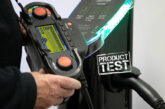
The Megger team answer your questions about testing EV charge points
You ask: Electric vehicle (EV) charge points are starting to become quite popular in my part of the world, but I’ve heard that when you’re testing them, you have to test the RCDs with both AC and DC current. Is that true and, if so, how do I do it?
We say: Yes, it is true. A charge point should be protected by its own 30 mA Type A RCD to provide earth fault protection. It must have additional protection (within the charge point) that provides disconnection of the supply in the case of DC leakage currents above 6mA. This could be an additional RCD or a protective device within the charging equipment itself. The best way to test these RCDs is to use an instrument that’s been specifically designed for the job, such as Megger’s latest MFT1741+ multifunction installation tester.
When you’re using an MFT1741+, you simply connect it to the charge point via an adaptor and select the AUTO EV testing mode. Then you use the adaptor to simulate the connection of a car to the charge point. As soon as it detects the charger switching on, the MFT1741+ starts the auto test sequence, which includes both the AC and DC tests. When the test is finished, you can recall the results to the screen or save them in the instrument’s internal memory for downloading later. It’s as easy as that!
For more Made 2 Measure articles from Megger, click here.








